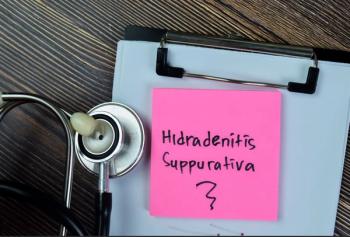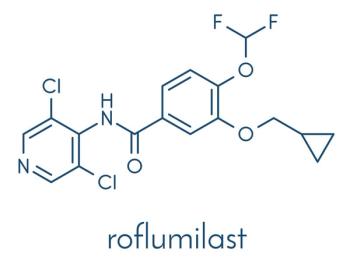
Guttate Hypomelanosis and Milia
For several months, a 49-year-old woman has had asymptomatic loss of pigmenton her shins. She has no history of injury to the area.What is your clinical impression?
Case 1:
For several months, a 49-year-old woman has had asymptomatic loss of pigmenton her shins. She has no history of injury to the area.
What is your clinical impression?
A.
Vitiligo.
B.
Lichen planus.
C.
Post-traumatic hypopigmentation.
D.
Guttate hypomelanosis.
E.
Tinea versicolor.
Case 1:
Guttate hypomelanosis, D,
is attributable to long-term sun exposurethat results in hypopigmentationfrom loss of melanocytes. It is typicallyseen on the shins and forearmsand is confined to sun-exposed surfaces.This distribution and appearancedistinguish it from vitiligo.Lichen planus can be associated withloss of pigment but is also associatedwith epidermal changes that are notseen here. Lichen planus generallypresents as flat-topped purple polygonalpapules sometimes accompaniedby sparse scale in the skin lines(Wickham striae). The patient has nohistory of trauma; moreover, the distributionand appearance do not suggest that the lesions were traumaticallyinduced. Tinea versicolor is associated with scaling, which is absent here; it istypically distributed on the trunk.Sunscreen is the first-line treatment for guttate hypomelanosis. Some successhas been reported anecdotally with tretinoin and alpha hydroxyl acids.
Case 2:
A 45-year-old woman complains that she has had asymptomatic white "bumps"on her cheeks for the past few months.
What does this eruption look like to you?
A.
Acne.
B.
Keratosis pilaris.
C.
Milia.
D.
Rosacea.
E.
Sebaceous hyperplasia.
Which of the following treatments would you consider?
A.
Adapalene.
B.
Tretinoin.
C.
Tazarotene.
D.
Azelaic acid.
E.
Salicylic acid.
Case 2:
The papules are
milia, C,
small occlusion cysts that can erupt atany age. Acne usually presents with acombination of open and closed comedones,as well as papules. Keratosispilaris generally occurs in infants andchildren, not adults. Rosacea typicallypresents with erythema and small inflammatorypapules and pustules.Sebaceous hyperplasia manifests withyellowish papules that have a centralpunctum.Adapalene, tretinoin, tazarotene,azelaic acid, and salicylic acid haveall been used to treat milia; however,the lesions may be slow to respond.Milia can also be extracted manuallyor lightly electrodessicated with acautery unit.
Case 3:
A 68-year-old man with long-standing "arthritis" presents with an eruption onthe thumb that had developed over the course of 2 years.
Which condition do you suspect is responsible for the patient's lesion?
A.
Rheumatoid arthritis.
B.
Psoriatic arthritis.
C.
Gout.
D.
Osteoarthritis.
E.
Calcinosis cutis.
Bonus question: True or false? Ninety-five percent of cases of this disorderoccur in men.
Case 3:
Tophi-nodular collections of sodium uratecrystals that can rupture spontaneously-are characteristicof
gout, C.
The differential includes calcinosis cutis, acondition sometimes associated with connective tissuediseases and marked by deposits of calcium salts in theskin. These can occur around the fingers and erupt spontaneously.Examination of the discharged material helpsdistinguish gout from calcinosis cutis. Spontaneous extrusionis not associated with rheumatoid arthritis, psoriaticarthritis, or osteoarthritis.
Answer to bonus question:
True; 95% of cases of goutoccur in men.
Case 4:
Hyperpigmentation developed on theface of a 35-year-old woman duringher last pregnancy, but it did not resolvefollowing childbirth.
You advise the patient to avoidexcessive sun exposure and to use asunscreen with an SPF of at least 15.
Which of the following ingredientswould you tell her to look for on thelabel of a sunscreen product?
A.
Homosalate.
B.
Zinc oxide.
C
. Methoxycinnamate.
D.
Oxybenzone.
E.
Butyl methoxydibenzoylmethane.
F.
Octocrylene.
G.
Titanium dioxide.
Bonus question: Which medication(s)can aggravate this condition?
Case 4:
The patient has
melasma,
hyperpigmented patches that occuron the face of some pregnant women.Melasma is aggravated by UV-A light.Zinc oxide, butyl methoxydibenzoylmethane,and titanium dioxide (
B,E,
and
G
) are efficient blockers ofUV-A; the others are much weaker.
Answer to bonus question:
Oral contraceptivescan aggravate melasma insome patients.
Newsletter
Enhance your clinical practice with the Patient Care newsletter, offering the latest evidence-based guidelines, diagnostic insights, and treatment strategies for primary care physicians.






















































































































































































































































































